Key Highlights
– Central bank decisions impact market liquidity: Interest rate hikes tighten liquidity, putting pressure on cryptocurrencies; pausing or cutting rates may drive speculative capital inflows. The policies of the Federal Reserve (Fed), European Central Bank (ECB), and Bank of England (BoE) will be key driving factors for the market.
– Inflation and economic growth determine risk appetite: Cooling inflation and strong economic growth are positive for the crypto market, while soaring inflation or weak economic data may trigger market sell-offs. Key data includes CPI (Consumer Price Index), PPI (Producer Price Index), GDP (Gross Domestic Product), and employment data.
– Geopolitics and regulatory dynamics increase market volatility: Escalation of the Russia-Ukraine war, heightened US-China tensions, or conflicts in the Middle East may trigger a rise in risk-off sentiment. However, positive regulatory developments, such as ETF approvals or the progress of MiCA (Markets in Crypto-Assets), may boost market confidence.
– Market sentiment and capital rotation are crucial: The crypto market is highly sensitive to macroeconomic trends, and traders will adjust their positions based on liquidity, interest rate expectations, and the economic environment. Market volatility is expected to increase significantly around the release of major economic data.

As the Altcoin market matures, the impact of macroeconomic events on digital asset price trends is becoming increasingly significant.
Economic indicators, central bank policy decisions, inflation reports, and geopolitical developments all influence traders' risk appetite. Whether you are a short-term Bit trader or a long-term investor, focusing on the key economic events in March will help you better navigate market volatility.
In this article, we will break down the most important economic events in March - from central bank rate decisions, inflation data, and employment reports to global political dynamics, and analyze how they will impact the Altcoin market. While Bit prices are typically influenced by unique factors such as blockchain technology and digital asset innovation, the macroeconomic environment still determines investors' confidence and positioning strategies in risk assets (such as Altcoins).
Table of Contents
Central Bank Meetings and Rate Decisions
– Federal Open Market Committee (FOMC) - March 18–19
– European Central Bank (ECB) - March 5–6
– Bank of England (BoE) - March 20
– Bank of Japan (BoJ) - March 18–19
– Other Central Banks (Bank of Canada BoC, Swiss National Bank SNB, Reserve Bank of Australia RBA)
– US Inflation Data (CPI: March 12, PPI: March 13)
– Eurozone Consumer Price Index (March 3)
– UK Inflation Report (March 26)
– China and Emerging Markets Inflation Data
– US Nonfarm Payrolls (NFP) - March 7
– Unemployment Rate and Wage Growth Trends
– JOLTS (Job Openings) - March 11
GDP (Gross Domestic Product) Reports
– US Q4 2024 Final Estimate - March 27
– UK GDP Report - March 14
– China Economic Outlook (National People's Congress & Q1 2025 Forecast)
– PMI (Purchasing Managers' Index) (Business Confidence) - Early March
– US Retail Sales & Consumer Confidence Index - Mid to Late March
– Industrial Production and Trade Data (Output, Exports, Durable Goods Orders)
Global Political Developments Impacting the Altcoin Market
– Russia-Ukraine War and Market Sentiment
– US-China Relations and Trade War
– Middle East and Other Geopolitical Hotspots
Altcoin Regulation and Policy Changes
– US SEC Regulation & Altcoin Legislation
– MiCA Framework & European Altcoin Regulatory Policies
– US Debt Ceiling and Fiscal Policy Impact
Major Economies' Developments and Investor Sentiment
– US Economic Outlook & Federal Reserve Policy
– Eurozone Economic Balancing Act
– China's Growth Target & Stimulus Policies
– Emerging Markets and Capital Flow Trends
Impact on the Altcoin Market in March
Central Bank Meetings and Rate Decisions
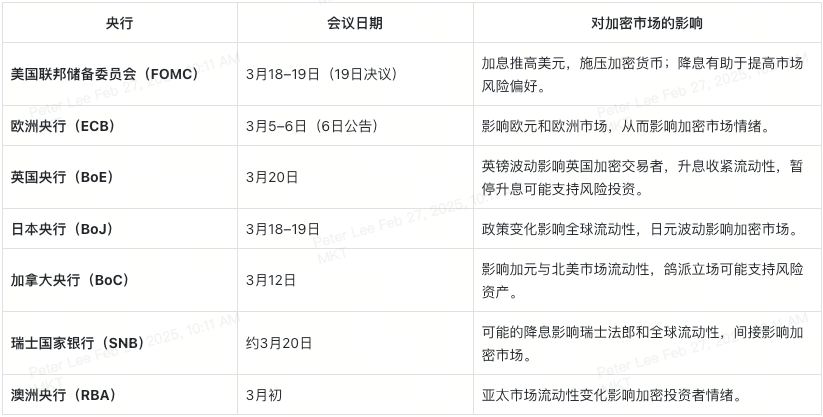
Federal Reserve (FOMC)
Meeting Dates: March 18–19 (Decision Announcement: March 19)
Impact Analysis:
The Federal Reserve's interest rate policy is a key driver for global markets and directly impacts the Altcoin market. Investors will closely watch for any changes in the policy direction.
Why is it important?
– Hawkish policy: Maintaining high interest rates will strengthen the US Dollar and put pressure on the Altcoin market.
– Dovish policy: If the Fed pauses or cuts rates, bond yields may decline, attracting speculative capital into the market, such as Bit and other risk assets.
– The Fed's policy statement and press conference usually trigger significant market volatility.
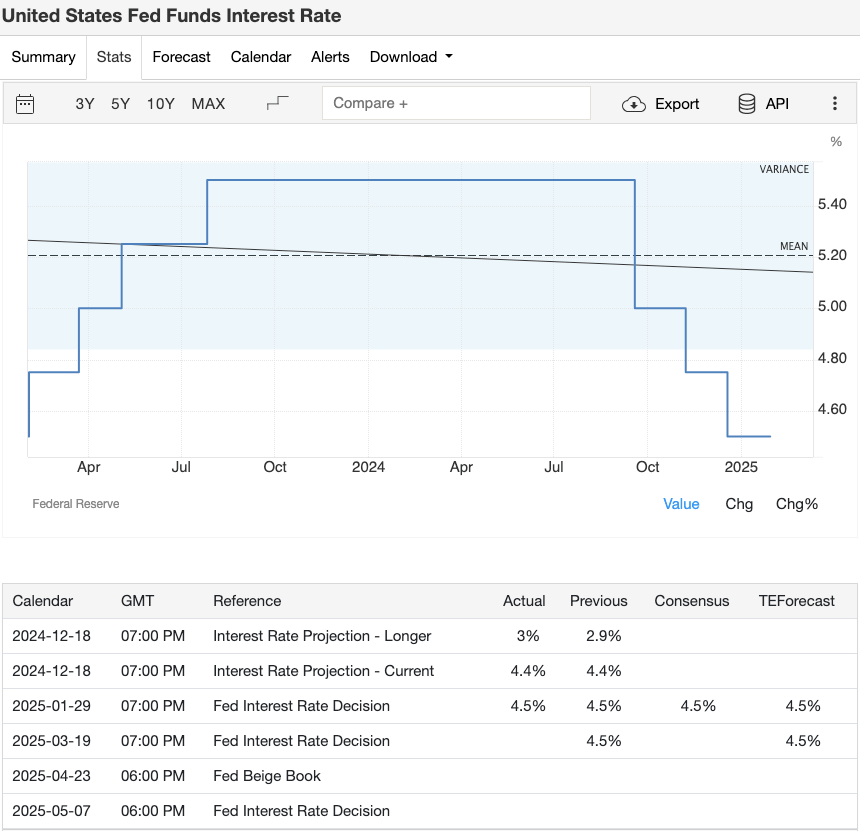
Image Credit: Trading Economics
European Central Bank (ECB)
Meeting Dates: March 5–6 (Decision Announcement: March 6)
Impact Analysis:
The ECB is working to balance inflation control and economic recovery.
Why is it important?
– ECB policy directly impacts the Euro and European markets, and indirectly affects Altcoin market sentiment.
– If the ECB signals a pause in rate hikes, investors' risk appetite may increase.
– If the ECB continues to hike rates or maintains a hawkish stance, the Altcoin market may face pressure.

Image Credit: Trading Economics
Bank of England (BoE)
Meeting Date: March 20
Impact Analysis:
UK inflation remains elevated, and the central bank needs to decide whether to continue tightening policy.
Why is it important?
– Fluctuations in the Pound will impact UK-based Altcoin traders.
– If the BoE chooses to hike rates, market liquidity will tighten, potentially reducing investment interest in Altcoin assets.
- The trend of European GDP is affecting global investment sentiment. If economic growth slows down, it may suppress the demand for risk assets.
- If GDP grows faster than expected, it may stabilize the market and promote investors' interest in Altcoins.
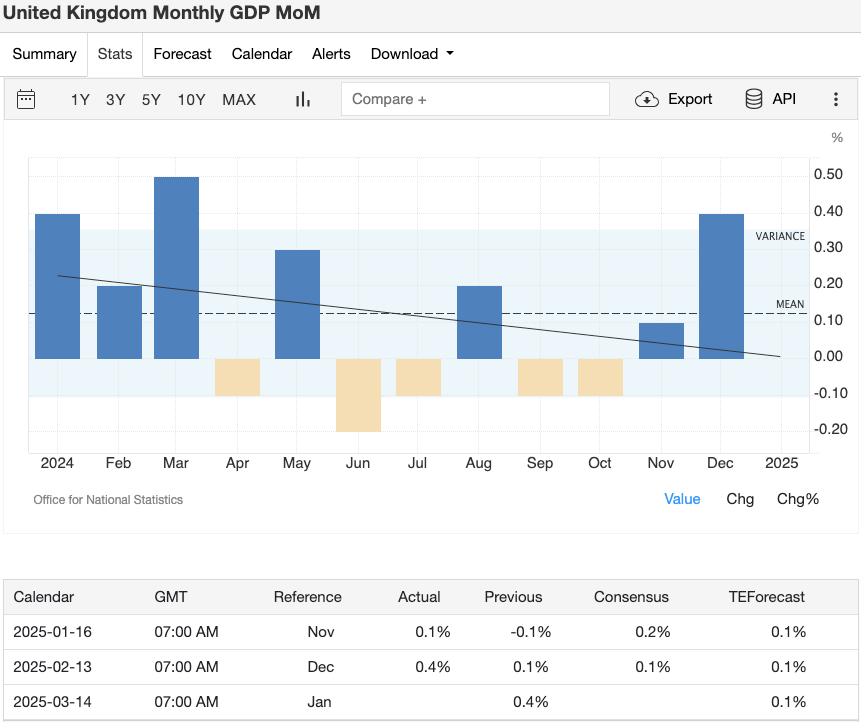
Image Credit: Trading Economics
China's GDP (Q1 2025 Data)
Release time: April (economic growth target set at the National People's Congress in March)
Why is it important?
- Strong economic growth in China: May drive up commodity prices and emerging markets, indirectly promoting capital inflows into the Altcoin market.
- Although China has banned domestic Altcoin trading, policy signals from Beijing will still affect global liquidity and investor risk appetite.
Other Key Economic Indicators

PMI Surveys
Release time: Early March (February PMI data)
PMI measures the business confidence index of manufacturing and service sectors, with data above 50 indicating economic expansion and below 50 indicating contraction.
Why is it important?
- Strong PMI (>50): Boosts risk appetite, which may promote capital inflows into the Altcoin market.
- Weak PMI (<50): Indicates economic slowdown, which may undermine market confidence and affect the demand for high-risk assets like Bit.
- Key data includes the US ISM Manufacturing PMI, Eurozone PMI, and China's official PMI.
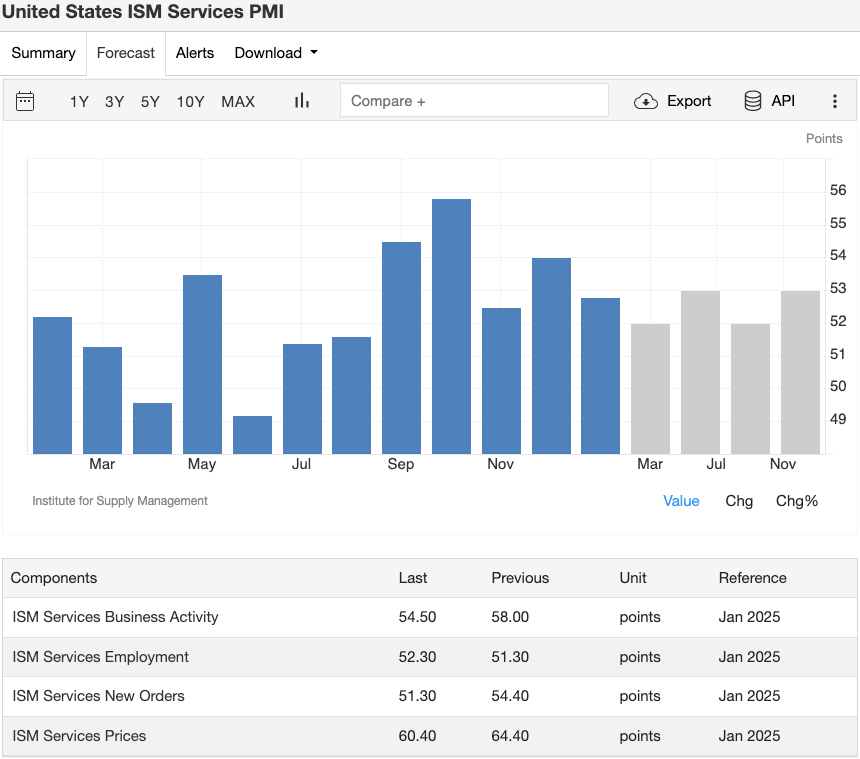
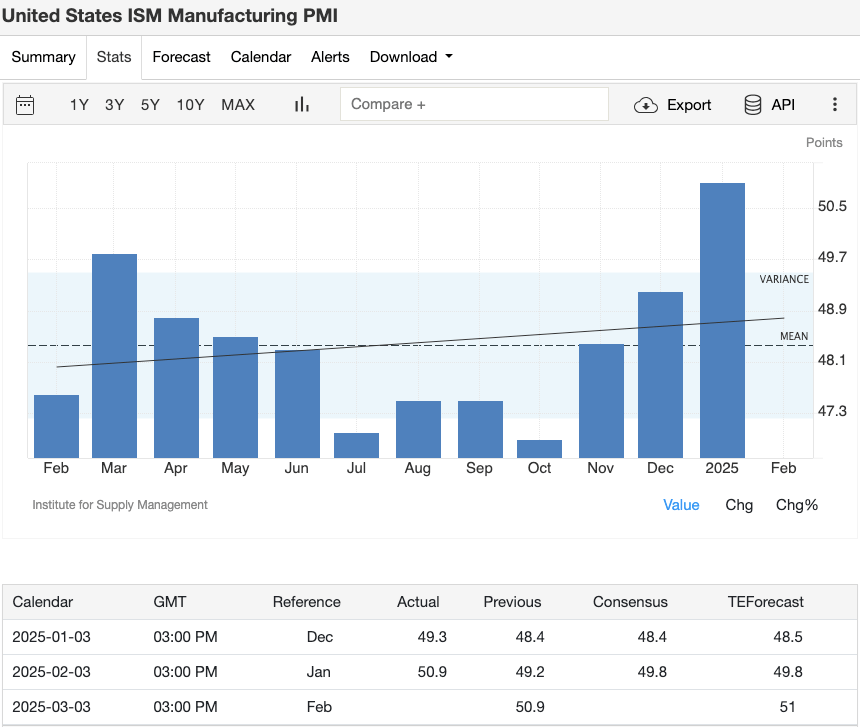
Image Credit: Trading Economics
Retail Sales and Consumer Confidence Index
Release time:
US Retail Sales (February data): Mid-March
Consumer Confidence Index:
- Conference Board: March 26
- University of Michigan: Mid-March
Why is it important?
- Weak retail sales may indicate that rate hikes have affected consumer spending, undermining market confidence.
- High consumer confidence may suggest economic stability, which could help drive the growth of risk assets like the Altcoin market.
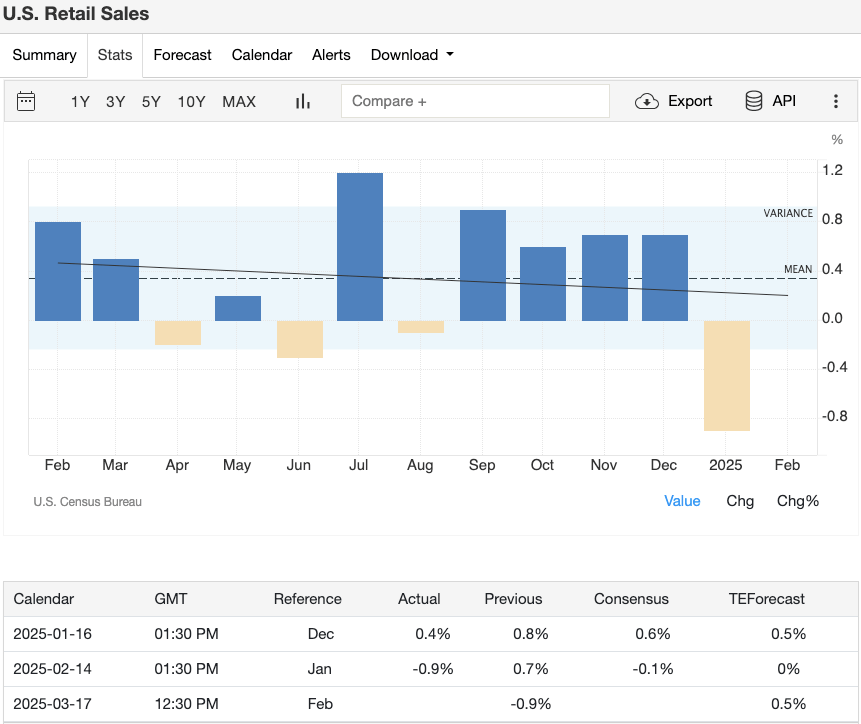
Image Credit: Trading Economics
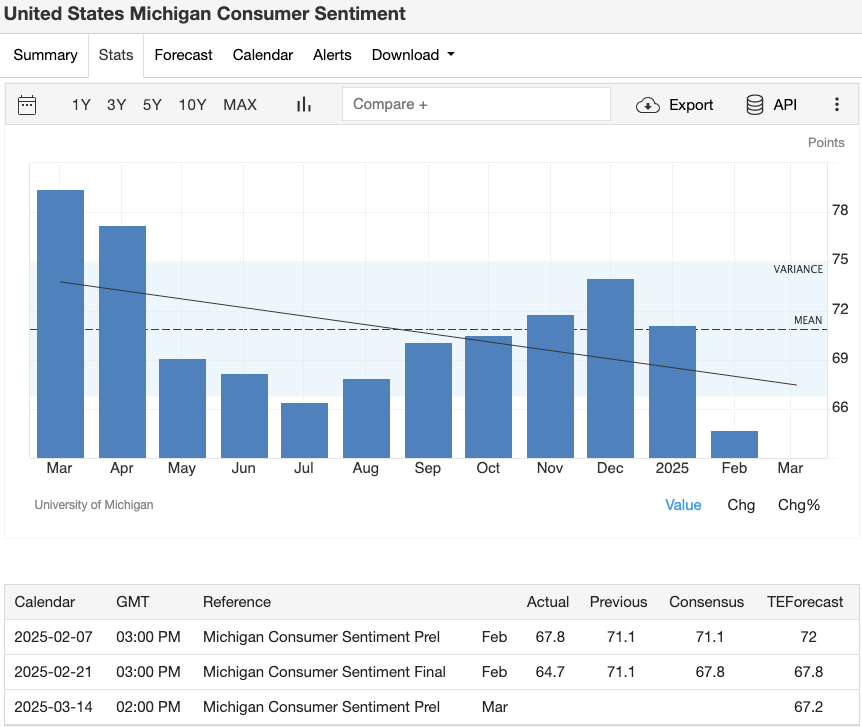
Image Credit: Trading Economics
Industrial and Trade Data
Covering: Industrial production, durable goods orders, and trade balance data
Why is it important?
- These indicators affect currency values and bond yields.
- Sustained strength or weakness in the data may change overall market sentiment, impacting Altcoin trends.
Global Political Developments Affecting the Altcoin Market
Russia-Ukraine War
The Russia-Ukraine conflict has been ongoing for nearly three years, and the market is highly sensitive to escalation or peace negotiations. When geopolitical risks rise, capital typically flows into safe-haven assets like the US dollar and gold, while risk assets (like Bit) face pressure.
Factors that may impact the Altcoin market:
- Expanded sanctions: If the US or EU imposes new rounds of sanctions on Russia, it may affect global market liquidity, indirectly impacting Altcoin prices.
- Escalation of military conflict: Intensified war may increase market risk aversion, undermining investment confidence in the Altcoin market.
- Diplomatic breakthrough: If a ceasefire agreement or progress in peace talks emerges, market risk appetite may rebound, benefiting risk assets like Bit.

Image Credit: Latest News and Updates
US-China Relations and Trade War
The US-China trade war, technology sanctions, and the Taiwan Strait situation continue to impact global markets. The recent US tariff hikes on Chinese imports have further increased market uncertainty, leading to heightened volatility in risk assets, including Altcoins.
Why is it important?
- Escalation of the trade war may exacerbate inflationary pressures, affecting the Fed's policies, and in turn, impacting risk assets like Bit.
- Supply chain disruptions may affect global economic stability, which is generally unfavorable for the Altcoin market.
- Bit as a hedge against inflation: Some investors view Bit as an inflation hedge, but historically, the uncertainty brought by trade wars has typically weighed on the Altcoin market in the short term.
- If the US and China make progress in trade negotiations or reach a new trade agreement, market confidence may rebound, benefiting the digital asset market.

Image Credit: International Relations Edu
Conflicts in the Middle East and Other Regions
Geopolitical hotspots in the Middle East, such as the tensions between Israel and Iran, OPEC+ oil production decisions, and disruptions in energy supply, may lead to a surge in oil prices, further exacerbating inflationary pressures and prompting investors to seek safe-haven assets.
Why is it important?
- Soaring oil prices: Typically, this will drive up inflation, prompting central banks to maintain tighter monetary policies, which is unfavorable for risk assets like Altcoins.
- Increased risk aversion: Investors may reduce their exposure to speculative assets (like Bit).
- Application of Altcoins in high-risk regions: In some extreme cases, Altcoins have been used for cross-border transactions or as financial safe havens, for example, in countries with currency devaluation or financial system instability.

Image Credit: Arabian Business
Altcoin Regulations and Policy Changes
Recently, regulatory policies in the US and Europe have undergone changes, affecting institutional adoption, enforcement actions, and investor confidence.
Altcoin Regulatory Updates
US Regulatory Updates:
- On February 20, 2025, the US Securities and Exchange Commission (SEC) established the Cyber and Emerging Technologies Unit (CETU), replacing the former Crypto Assets and Cyber Unit, focusing on combating fraud and protecting retail investors.
- The SEC has concluded its investigations into OpenSea and Coinbase, suggesting a potentially more lenient regulatory stance towards the Altcoin industry.
European Regulatory Updates:
- The Markets in Crypto-Assets (MiCA) regulatory framework is progressing, with the EU releasing technical standards on February 20, 2025, and the regulation set to take effect on March 12, 2025, aiming to harmonize Altcoin regulations across Europe.
Why is it important?
- The SEC's stance may become more accommodating, benefiting Altcoin industry innovation, but the establishment of CETU indicates that enforcement efforts still exist.
- The advancement of the MiCA regulatory framework will standardize European regulatory rules, potentially increasing the likelihood of institutional capital entering the Altcoin market.
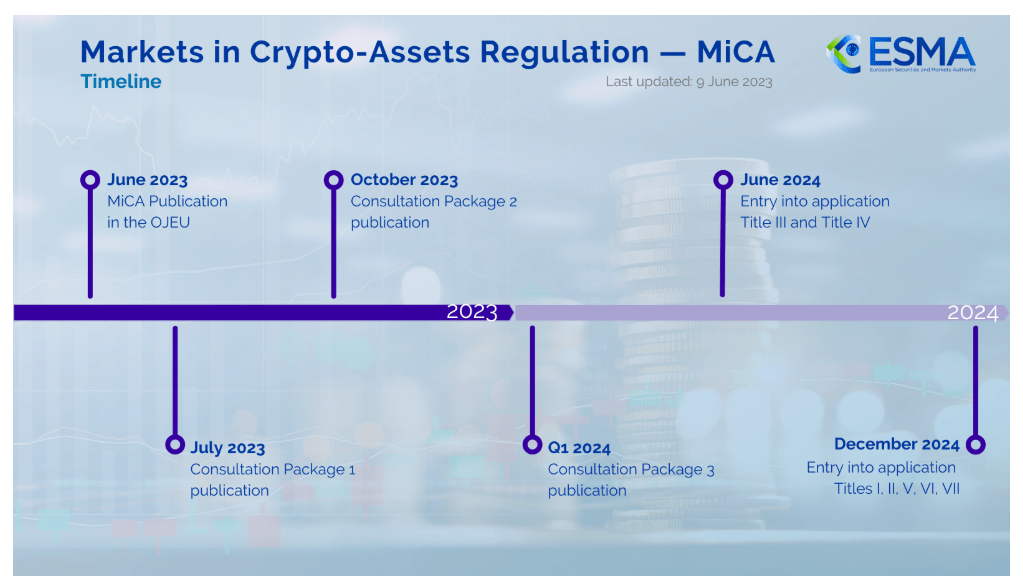
Image Credit: The News Crypto
Key Legislative Changes Impacting the Market
US Debt Ceiling Issue:
On January 2, 2025, the US government reset the debt ceiling to $36.1 trillion, but the issue remains politically contentious, increasing market uncertainty.
Why is it important?
- Uncertainty around fiscal policy may exacerbate market volatility.
– Bitcoin is seen as a safe-haven asset, but historically, debt crises have typically led to widespread market selloffs first, followed by market stabilization.
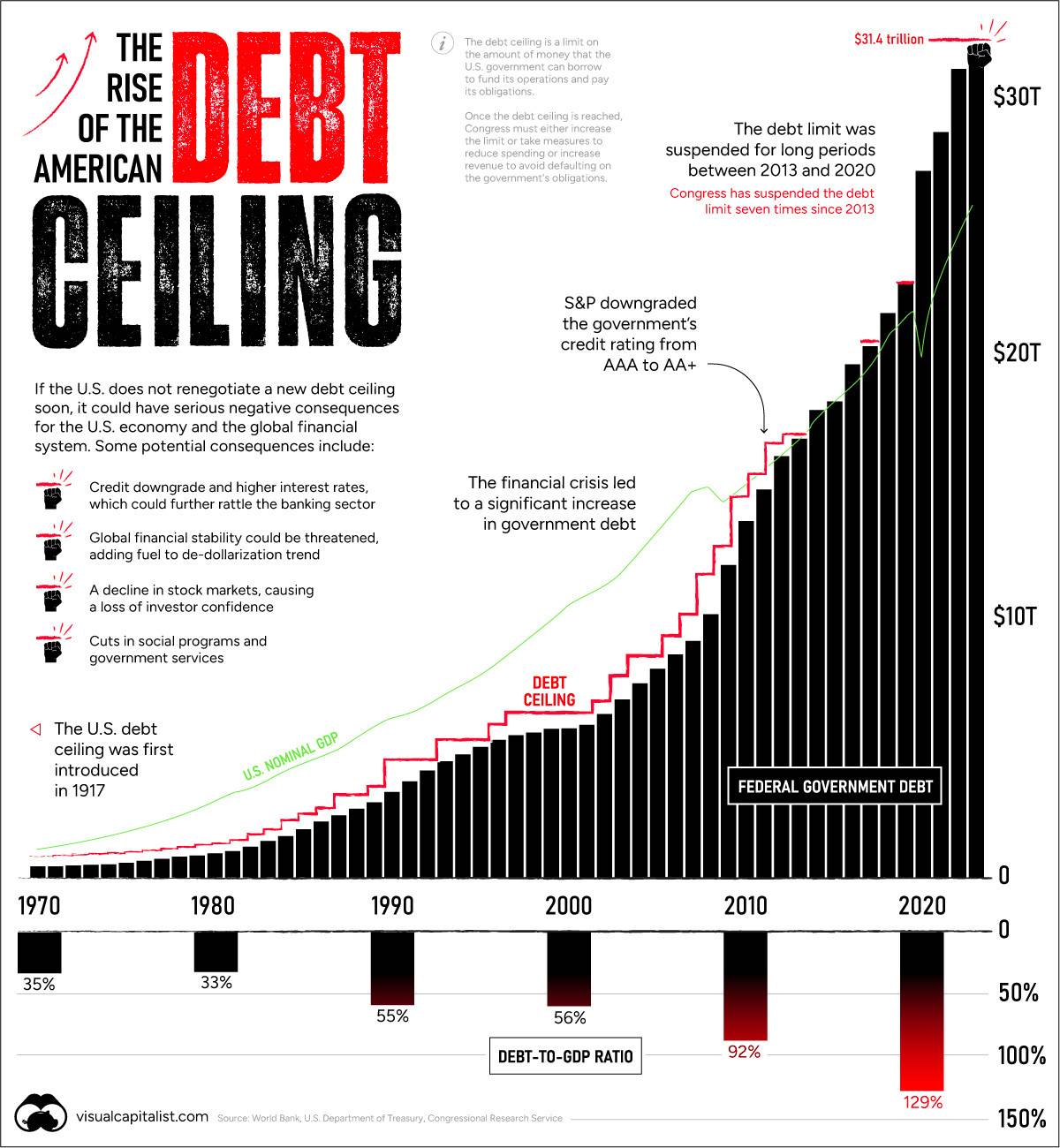
Image Credit: Visual Capitalist
Policy Changes in Major Economies
New Luxembourg Law:
On February 6, 2025, Luxembourg passed a new law that integrates EU crypto regulations with green bond regulations, further consolidating its position in digital asset regulation.
Why is this important?
– Luxembourg's regulatory model may influence other jurisdictions, driving the harmonization of the global crypto regulatory framework.
Changes in regulatory policies will continue to impact market stability, capital flows, and the adoption of cryptocurrencies, making it crucial to stay vigilant.
Developments and Investor Sentiment in Major Economies
The US Economy
The market is focused on whether the Federal Reserve (Fed) can control inflation without triggering a recession.
– Strong labor market + cooling inflation: Positive for the stock market and the crypto market.
– Weak economic data: May trigger a risk-off sentiment, with capital flowing into the US dollar and gold, which would be unfavorable for crypto assets.
– Expectations of future rate cuts: If the market believes the Fed will ease monetary policy, it may boost risk assets like Bitcoin.
The European Economy
The Eurozone is currently balancing the control of inflation and economic growth.
If the European Central Bank (ECB) signals a pause in rate hikes, the market may rebound.
Energy prices remain a key factor:
– If the Russia-Ukraine war escalates, rising energy prices may trigger inflation concerns.
– If the energy market stabilizes, it would support European economic growth, which would be positive for the crypto market.
The Chinese Economy
The National People's Congress (NPC) will set the 2025 economic growth target in March.
– Potential stimulus measures: Infrastructure investment, loose monetary policy, etc., which could drive the growth of commodities and emerging markets.
– Although China restricts domestic crypto trading, economic growth still influences global risk appetite, indirectly affecting cryptocurrency prices.
Emerging Markets
If major central banks pause rate hikes, capital may flow into emerging markets, driving the rise of risk assets, which would be positive for cryptocurrencies.
– Potential risks: Debt crises or political instability may trigger a risk-off sentiment, leading to capital outflows.
The Impact on the Crypto Market in March
Interest Rates and Market Liquidity
Central bank decisions will directly impact the crypto market:
– Rate hikes: Tightening market liquidity, putting pressure on Bitcoin and other Altcoins.
– Pause in rate hikes or rate cuts: May release capital inflows into the market, strengthening speculative sentiment and driving up cryptocurrency prices.
Inflation and the "Store of Value" Narrative
– Cooling inflation: Reducing market concerns about further rate hikes, which would be beneficial for the crypto market growth.
– If inflation rises again: Central banks may maintain a hawkish policy, weakening market risk appetite, which would be unfavorable for cryptocurrencies.
Bitcoin as "Digital Gold": Long-term inflation may strengthen Bitcoin's store of value characteristics, but the market is still more focused on interest rate expectations.
Economic Growth and Risk Appetite
– GDP growth and a strong labor market: Generally positive for risk assets, including cryptocurrencies.
– Economic growth slowdown: May lead to market selloffs in the short term, but if the market expects central banks to cut rates, it could provide long-term support for the crypto market.
Geopolitical Risk and Capital Flows
– During crises, rising market risk aversion typically impacts cryptocurrencies.
– If geopolitical instability persists, it may highlight the advantages of decentralized crypto assets, attracting some capital inflows.
Regulatory Dynamics and Market Confidence
– ETF approvals, clear regulatory policies, or friendly regulations may drive market upswings.
– Bans or litigation may increase market uncertainty, leading to violent price fluctuations.
Market Sentiment and Capital Rotation
– Changes in market liquidity affect the capital rotation between cryptocurrencies and the stock market.
– Traders should pay attention to volatility around the release of important economic data, as this may lead to sharp price movements in the short term.







